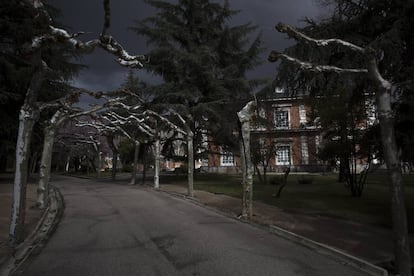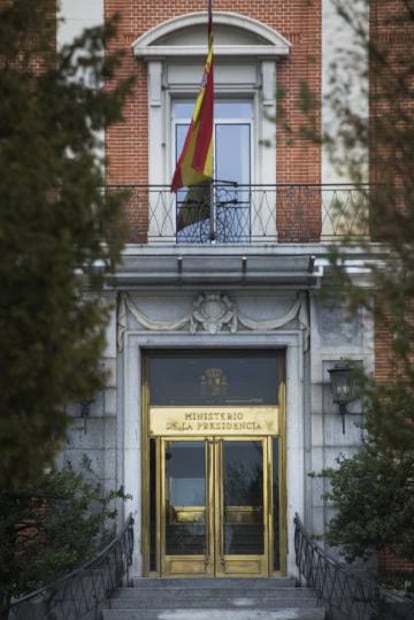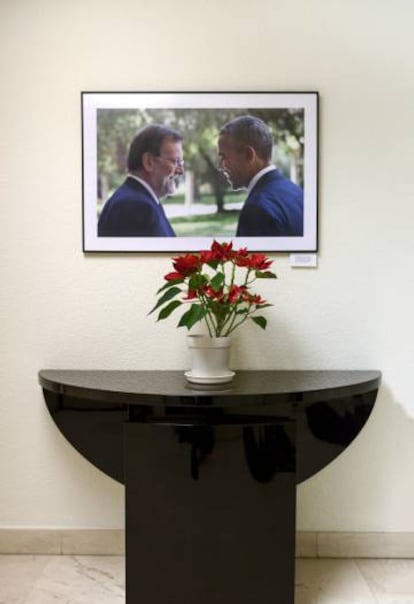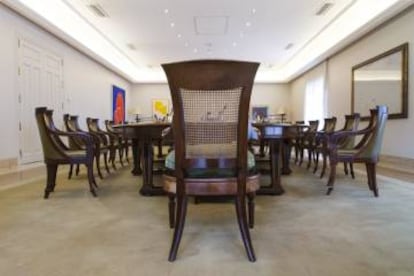Moncloa Confidential: A peek inside the Spanish PM’s seat of power
Spain’s epicenter of influence lies just five minutes from Madrid. With the sole purpose of supporting the country’s leader, this miniature city is accessible to only a few. Here is how it works

The lights go on in the H-shaped building next to the high-security wing that holds the prime minister’s office just before 8am, just as Spanish Prime Minister Mariano Rajoy is finishing up on the treadmill. The so-called Semillas building, built in 1950 in the magisterial revivalist style, was once used as a seed laboratory. In 1977, under transitional Prime Minister Adolfo Suárez’s watch, it was turned into a powerhouse for ideas and has been accommodating the administrations of Spanish prime ministers ever since.
This is where Rajoy’s chief of staff, José Luis Ayllón, conducts the traffic of information alongside Eva Valle, director of the Economic Department and Cristina Ysasi-Ysasmendi, the head of national security and the Cabinet’s second-in-command: a trio consisting of a politician who has fought his way up from the bottom; a technocrat from the International Monetary Fund and a senior civil servant who knows the workings of the administration inside out.

Together, they are the prime minister’s eyes, ears, voice and, when necessary, jackboot. They are the analysts who must advise him of the risks at each political turn; who interpret his thinking and compose memorable speeches; who come up with responses and rapid, caustic, well-founded retorts for his parliamentary sessions – and Rajoy is obsessive about the source of each piece of data he is given. They must turn him into the nation’s indisputable leader; track compliance with electoral promises; coordinate, observe and sort out stagnating and dysfunctional ministerial departments; advise him what to do, who to see, where to go.
As José Enrique Serrano, chief of staff for former Socialist Party (PSOE) Prime Minister José Luis Rodríguez Zapatero between 2004 and 2011, says: “You have to protect the prime minister even from himself; calculate the timings of each bill, and know when to freeze it; manage the crises and analyze the polls; keep on top of the delicate relationship with the Crown – all the king’s speeches, including the Christmas speech, are read and edited from La Moncloa, where the agenda for the Monday meetings between Felipe VI and Rajoy is prepared; attend to the public – there are around 30,000 citizen requests during each political term and 99% are answered. You even feed his Twitter account.”
You have to protect the prime minister even from himself Former chief-of-staff José Enrique Serrano
And, according to Carlos Aragonés, chief of staff for former Prime Minister José María Aznar between 1996 and 2004: “All this without forgetting your own place. You are a consultant, a mediator and a secretary. You are the major-domo. The tug boat can’t be the one driving the aircraft carrier,” he says. “You don’t decide: you help and advise. You can’t have your own agenda. If you want real power you have to aspire to a ministry, not work in La Moncloa. The staff have influence and delegated power, not raw power. When you call a minister, he or she knows who you’re calling on behalf of. You can demand everything the prime minister wants to see from them. Everything! And then you get to see what he lets you see. The prime minister is, by far, the best-informed person in the country.” These words are confirmed by his successor and good friend, José Enrique Serrano.
“The prime minister decides how much you should know,” he says. “For example, reports from the National Intelligence Center (CNI) arrive at Semillas inside a sealed envelope. You pick it up. And the prime minister will share its contents with you, or not. The prime minister is the CNI’s customer. The state is a mountain and the higher up it you get, the more you see. But there’s only space for one at the top. That’s the person who sees everything. Because that’s the person who has to make the decisions.”

Serrano insists that the manner in which each staff team works depends on the personality of the prime minister. Eurodeputy Enrique Guerrero, who was Zapatero’s right-hand man in La Moncloa during his first term, agrees. “Zapatero trusted his circle outside Moncloa and he was on the phone all day,” he says. “Aznar was very disciplined and used a more formal structure. And Felipe [González] had his own criteria, intuition and capacity for analysis. He was more unorthodox about the way he used his staff than Aznar. But they both read everything.”
International director of the Planeta group’s training division Gabriel Elorriaga, who was deputy chief of staff for Aznar between 1996 and 2000, recalls: “Aznar read all the documents we passed him and returned them underlined with comments. He was a stickler.”
And Rajoy? One former member of his advisory team says: “He’s an easier person than Aznar but harder to advise. He doesn’t like to take the initiative. He thinks decisions through at length. Advising him is less productive than with other prime ministers.”

The staff during Felipe González’s government was more numerous and loyal and it was also committed to controlling the ministers working under González’s deputy, Alfonso Guerra. Aznar, meanwhile, handed La Moncloa over to a young liberal-minded posse that formed a very tight ideological squad. Faced with his unexpected victory in 2004, Zapatero initially relied on members of Felipe’s staff, then shaped his own during his second term, with his cousin José Miguel Vidal Zapatero at the helm. Finally, Mariano Rajoy who moved into La Moncloa mid-crisis, appointed the diplomat Jorge Moragas as his chief of staff, who made use of senior civil servants, confining himself to foreign policy and security and turning his back on the economy, which was placed in the hands of Álvaro Nadal and Eva Valle.
To provide the president with the best conditions for what Aragonés describes as “the tremor of making a big decision,” these teams must feed him unbiased information from independent sources. Briefs for the president’s eyes only are concise and, if possible, entertaining – to ensure they are actually read. “They should juxtapose information from various sources, using honesty, intellectual freedom and critical assessment,” explains Cristina Sádaba, Rajoy’s former advisor on national issues.
Around 2,000 members of staff work in Moncloa
Each expert in La Moncloa is asked for input on the briefs and the cocktail of information is given the okay by the heads of staff before being served up to the prime minister. “When the head of government has to take a crucial decision, he or she never chooses between a good and a bad option, but rather between a bad and worse one,” says diplomat Bernardino León, secretary general of the PM’s Office during Zapatero’s term between 2008 and 2011 and now director of the Emirates’ Diplomatic Academy.
According to Ambassador Carlos Alonso Zaldívar, who was head of one of Felipe González’s executive departments between 1990 and 1994, “when you draw up a report for the prime minister you never know if it is going to be taken on board. But even if he takes the opposite view, you have to treat his decision as though it were your own. And argue for it. That’s called being loyal. It’s a lesson in humility. And that’s good in La Moncloa, where there are a lot of egos,” he says.
Working in the prime minister’s “laboratory” isn’t easy. Nor is it peaceful despite its pastoral setting and the immaculate corridors in the Semillas building, where analysts quietly go about their business. Time is of the essence. Reality crushes the best-laid plans. It’s all about forging a path and leading the way. “There are three elements that complicate life when it comes to advising the prime minister,” says Antonio Núñez, the social policy advisor between 2012 and 2014. “The speed of events, the complexity and variety of the matters in hand, and the pressure coming from lobbyists.”
“The affairs that reach his desk are always complicated,” says Bernadino León. “It’s all difficult. In La Moncloa, there’s never a good day. You have to have the right frame of mind and be particularly tough to work there. It’s called statesmanship.”

The chief of staff is connected to the prime minister 24 hours a day, 365 days a year, with vacations inevitably interrupted and 12-hour working days carried out against a backdrop of chirping birds and whispering cedars. His domain is the enormous office on the first floor of the Semillas building that once belonged to Felipe González’s deputy, Alfonso Guerra. To the right of the massive desk is the high security video-conference system, Malla B, which has protected communication lines to the state’s most powerful men and women. On the desk itself is a ton of papers and the odd file with an ominous “Destroy!” scribbled across it.
José Luis Ayllón, who was appointed chief of staff in January, leaves the building after 11pm, the last of Rajoy’s colorful and multi-disciplined team to depart. The directors of each department are generally considered oddballs by their own parties; distant, aloof and solitary figures who take pride in their humility – a stuffy persona that results from the curious love-hate relationship they have with their bosses.
“You are the only person that can get mad at the prime minister,” says Jorge Moragas who was Rajoy’s chief of staff between 2011 and 2017. “No one else dares. His ministers have a private audience with him every couple of weeks. Nobody argues with him except for you. It goes with the territory. But you have to be measured in your criticism. You can’t abuse the closeness of the relationship. You can’t be chewing his ear off all day long.”
You’re the only one that can get mad at the prime minister Diplomat Jorge Moragas
José Enrique Serrano, who worked with both Felipe González and Zapatero, says: “When the prime minister makes a decision, the chief of staff has to have taken everything into account. But the prime minister doesn’t do this. Power can blind you. The day comes when the words, ‘Prime minister, you can’t do that!’ can be heard in Moncloa. And they reply, ‘But I won the elections!’ and you say, ‘The law dictates you must do things in a certain way.’ You have to be brave to make them see reality. Because it is the prime minister.”
Miguel Sebastián, head of Zapatero’s Economy Department between 2004 and 2006, says: “I was his devil’s advocate. I only told him the truth. If he was happy because unemployment had dropped by two points, I poured cold water on his mood and explained that it would soon return to 15%. I was his personal economic pain in the ass.”

Director of Aznar’s FAES think tank Javier Zarzalejos, general secretary of Moncloa between 1996 and 2004, believes it is crucial to make the president recognize the truth, however unpleasant it is. “Otherwise, you run the risk of turning yourself into ‘Pharaoh’s Court’ with no tension or debate,” he says. “He hasn’t been elected so he can have an easy life. Your work is to protect him but not isolate him. He can’t be at everyone’s disposal but neither can he be in a bubble.”
When it comes to personalities in this power enclave, José Enrique Serrano would be the politician with a capital P: a professor of law who took decades to ask for his PSOE party membership card but who was constantly ruminating on affairs of state. Carlos Aragonés is the liberal philosopher, as skeptical in political matters as he is conservative in his habits; Jorge Moragas, a restless diplomat and a stickler for protocol who has seen three prime ministers come and go over 13 years. And José Luis Ayllón, a workaholic with a broad vision who built consensus for the transparency laws as well as being a close friend of Deputy Prime MInister Soraya Sáenz de Santamaría and a key player in Rajoy’s future electoral designs. He is not an expert on foreign affairs or an old boy of any great state institution, but he is excellent at national policy advice, which is crucial for Rajoy.

Besides Ayllón, the prime minister’s ‘brain’ consists of 47 advisors, divided between the staff in the north wing of the Semillas building and the Economic Department in the south wing. The basement is home to the Citizen’s Care Office and there is a passage policed by the Civil Guard that connects Semillas with the Rajoy’s private wing. It takes two minutes to get from Ayllón’s office to Rajoy. The prime minister’s high security zone is connected to his teams by three strategic points – the staff, the deputy prime minister and the spokesman who deals with communication. Behind this building lie Adolfo Suárez’s tennis courts, Aznar’s paddle courts and Zapatero’s basketball court. Nowadays, the area is as dead as the abandoned greenhouses where Felipe González once grew oranges.
The General Secretariat is on the second floor of Semillas’ south wing. State Attorney Charo Pablos heads the operation here with military figures Colonel Andrés Costilludo, who deals with both prime ministerial and state protocol, and Colonel of the Civil Guard Alejandro Hernández Mosquera, who is in charge of security. The number of security staff under his charge is a state secret, though it is said to be between 600 and 700 – a combination of Civil Guards and policemen, 50 of whom rotate the daily security of the prime minister’s inner circle in three shifts.
The prime minister’s office has a €36-million budget
The sole objective of La Moncloa is to support the prime minister, according to Jorge Moragas. “Based on that premise, the staff could be considered the political software and the General Secretariat, the hardware – the tangible element that ensures everything runs smoothly, from the trips and communications to the technology and logistics. The advisors come and go but this technical and administrative side of the General Secretariat is crucial in ensuring continuity, despite a change of prime minister.”

The secretary generals, who are responsible for knowing the exact whereabouts of the prime minister at all times, are highly trusted professionals entrusted with delicate state missions, such as Javier Zarzalejos, a key player in the Aznar administration’s fight against ETA, or Bernardino León, who was Zapatero’s right-hand man at the G20 and his special international advisor since 2008. “One fine day, the heads of state discover international relations and they become fascinated because it’s the ultimate political game. In their second term, they move from Soria to Syria. And you have to
hold their hand,” says León.
Zarzalejos recognizes that the staff and the General Secretariat don’t work easily together. Nor does Moncloa’s international department and the Ministry of Foreign Affairs (Moragas does not get along with Minister Margallo). The Economy Department does not rub along very well either with the Treasury – Barea and Rato and Sebastián and Solbes can hardly stand the sight of each other. There’s also friction between the staff and the deputy prime minister. According to Javier Zarzalejos, “logical tensions arise. Each person has to find his or her niche. You have an organic place but that is only a part of what the prime minister might entrust you with. Aznar asked me to play strategic roles in the Basque Country, and I didn’t offer opinions on economic or social issues. That’s how Aznar dealt the cards. And it worked.”
So what is happening with Soraya Sáenz de Santamaría, the all-powerful deputy prime minster? According to one insider: “She confines herself to being the special legal advisor to the prime minister. She is less influential than is generally believed.”
You don’t make friends in this line of work Former advisor Gabriel Elorriaga
The prime minister’s office accounts for €36 million of the €1.2-billion budget set aside for the Prime Ministerial Ministry. The analysts are on annual salaries ranging from €60,000 to €100,000 – not much compared to what an analyst might earn in the private sector, which makes it hard to attract talent from outside. Of the 47 “brains” in Semillas, 23 are senior civil servants and 24 have been headhunted. They are all on maximum pay. “But the money is the least of it,” says Moragas. “I had the chance to go into government and said no. The ministry I was offered by the prime minister didn’t interest me. There are 13 ministers and only one chief of staff.”
The consultants are a mix of senior officials, parliamentary advisors, professors, consultants, sociologists, social network experts and gurus. The structure depends on the scenario – whether the economy, foreign policy or national policy is on the immediate agenda. According to political science professor Juan Luis Paniagua: “The advisors are often young university lecturers or someone who has recently entered the civil service. They don’t have masses of experience or unequivocal affiliation. But it’s crucial that they know how to look for and administer information.”

They are known in politics as the porters, the plumbers, the cooks or princes of darkness. They are invisible but their presence is felt. The leader talks through them. When a leader steps down, they disappear into thin air, relegated to oblivion. “You don’t make friends in this line of work,” says Gabriel Elorriaga, who was second in command in Aznar’s staff. “You get known as a pest. You come into conflict with ministers because you only tell the prime minister what they are doing badly, not what they are doing well. The ministries are madhouses that are constantly clashing with each other; particularly with the Treasury. And you have to sort things out. You are present in all the administration’s most important collective management bodies. And you are the prime minister’s man.”
“This job is not a trampoline,” says José Luis Ayllón. “And that suits me. I’m not a mythomaniac. I don’t get vertigo in this position. I know what it’s about. I’ve spent six years with the deputy prime minister as Secretary of State for Relations with Parliament. I’ve even talked in Congress with Amaiur [a left-leaning coalition party operating in the Basque Country and Navarre]. And in 2011, I was involved in the transfer of power from the PSOE. And now it’s about supporting the prime minister. Tomorrow, we’ll see.”
La Moncloa sits on 20 hectares of land. One third of this is the prime minister’s security zone, completely fenced off from the rest. It would be hard for an intruder to find his or her way around this labyrinth. The only way to really grasp the scale of it and not get lost is to walk around the boundary. It stretches from the Moncloa Palace, built on a 17th-century estate in 1953 by Diego Méndez, the state architect of dictator Francisco Franco, and surrounded by monastic barracks belonging to the Ministry of Agriculture. This is where Adolfo Suárez was installed in 1977. At that time, the cabinet would meet in the dining hall until it was converted into the power complex it is today, eight minutes by car from the CNI and 10 from the Zarzuela Palace, home to the king.
The entire Moncloa complex consists of 16 buildings, which provide office space for 2,000 members of staff. Besides the Semillas building, it features a heliport, the deputy prime minister’s mansion, the Prime Ministerial Ministry, service, security, protocol and communications buildings; a gym, bank, clinic and post office; and a bunker that has a high-security door behind which lies the National Security Department run by Captain Joaquín Castellón. This is where the prime minister operates when dealing with crises. One of the last such occasions was during Prince Felipe’s wedding in 2004, when there was a threat of assassination.
Cristina Ysasi, second-in-command in Semillas, says that when she arrived at La Moncloa in 2011 after Rajoy’s electoral triumph, it was like a ghost town. The analysts’ offices were bare and the hard disks empty. It has always been the way. When it comes to a transfer of power, all the material generated by the outgoing staff is spirited away.
“The office missives are cleared from the Moncloa server. The prime minister takes them away in digital format,” says Carlos Aragonés, Aznar’s man between 1996 and 2004.
This means the key documents distilled by staff members miss out on a place in the history books. “It’s true that they could be filed in a general archive for the administration because they explain how things happened but they are political documents,” says Aragonés. “They include appraisals – of ministers, businessmen and world leaders – that are not always pleasant. They contain serious judgments, operative analysis and advice on what the prime minister should do in each situation. Maybe it’s better that what really happened is never revealed, that it remains within these four walls.”
English version by Heather Galloway.


